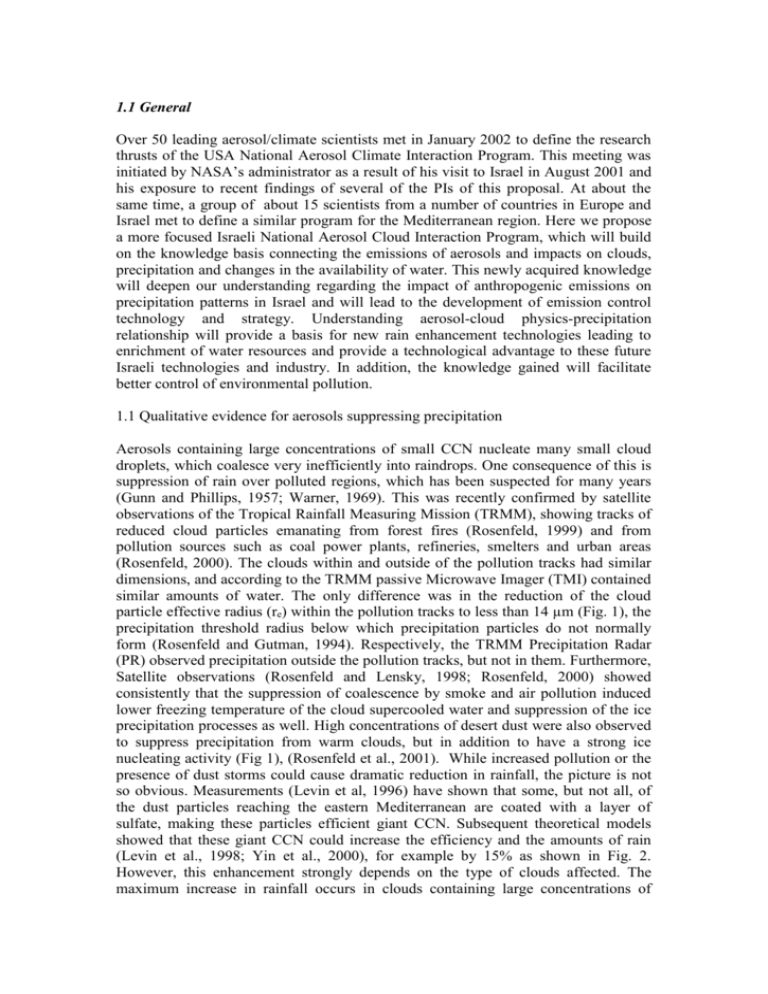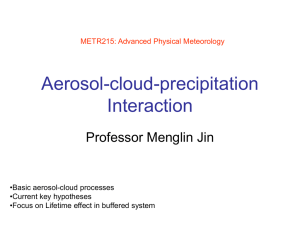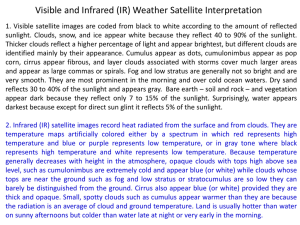read the overview
advertisement

1.1 General Over 50 leading aerosol/climate scientists met in January 2002 to define the research thrusts of the USA National Aerosol Climate Interaction Program. This meeting was initiated by NASA’s administrator as a result of his visit to Israel in August 2001 and his exposure to recent findings of several of the PIs of this proposal. At about the same time, a group of about 15 scientists from a number of countries in Europe and Israel met to define a similar program for the Mediterranean region. Here we propose a more focused Israeli National Aerosol Cloud Interaction Program, which will build on the knowledge basis connecting the emissions of aerosols and impacts on clouds, precipitation and changes in the availability of water. This newly acquired knowledge will deepen our understanding regarding the impact of anthropogenic emissions on precipitation patterns in Israel and will lead to the development of emission control technology and strategy. Understanding aerosol-cloud physics-precipitation relationship will provide a basis for new rain enhancement technologies leading to enrichment of water resources and provide a technological advantage to these future Israeli technologies and industry. In addition, the knowledge gained will facilitate better control of environmental pollution. 1.1 Qualitative evidence for aerosols suppressing precipitation Aerosols containing large concentrations of small CCN nucleate many small cloud droplets, which coalesce very inefficiently into raindrops. One consequence of this is suppression of rain over polluted regions, which has been suspected for many years (Gunn and Phillips, 1957; Warner, 1969). This was recently confirmed by satellite observations of the Tropical Rainfall Measuring Mission (TRMM), showing tracks of reduced cloud particles emanating from forest fires (Rosenfeld, 1999) and from pollution sources such as coal power plants, refineries, smelters and urban areas (Rosenfeld, 2000). The clouds within and outside of the pollution tracks had similar dimensions, and according to the TRMM passive Microwave Imager (TMI) contained similar amounts of water. The only difference was in the reduction of the cloud particle effective radius (re) within the pollution tracks to less than 14 µm (Fig. 1), the precipitation threshold radius below which precipitation particles do not normally form (Rosenfeld and Gutman, 1994). Respectively, the TRMM Precipitation Radar (PR) observed precipitation outside the pollution tracks, but not in them. Furthermore, Satellite observations (Rosenfeld and Lensky, 1998; Rosenfeld, 2000) showed consistently that the suppression of coalescence by smoke and air pollution induced lower freezing temperature of the cloud supercooled water and suppression of the ice precipitation processes as well. High concentrations of desert dust were also observed to suppress precipitation from warm clouds, but in addition to have a strong ice nucleating activity (Fig 1), (Rosenfeld et al., 2001). While increased pollution or the presence of dust storms could cause dramatic reduction in rainfall, the picture is not so obvious. Measurements (Levin et al, 1996) have shown that some, but not all, of the dust particles reaching the eastern Mediterranean are coated with a layer of sulfate, making these particles efficient giant CCN. Subsequent theoretical models showed that these giant CCN could increase the efficiency and the amounts of rain (Levin et al., 1998; Yin et al., 2000), for example by 15% as shown in Fig. 2. However, this enhancement strongly depends on the type of clouds affected. The maximum increase in rainfall occurs in clouds containing large concentrations of drops (~1000 cm-3). Although the actual rainfall amounts from these types of clouds is relatively small, the percent increase is large (see Fig. 2). Maritime clouds, with CCN concentrations as low as 100-200 drops cm-3 are hardly affected by such giant CCN and in fact, may lead to a decrease in the rain amounts (Yin et al, 2002). According to results obtained using a spectral-microphysics 2000-bin cloud parcel model (Pinsky and Khain, 2002; Khain et al, 2002) effect of large CCN on precipitation depends on the distance between the level of beginning of intensive rain drop formation (the level of collision triggering) and the cloud top level. In case the distance is comparatively small (less than about 1 km) additional large CCN can increase accumulated rain significantly (up to 5 times), while in case the distance is large (those clouds realize all their precipitation potential) the additional amount of large CCN leads to a decrease in precipitation in agreement with results by Yin et al (2002). Although the effect on precipitation has been documented so far only on the basis of case studies, it is likely to be a major factor in reducing or increasing precipitation efficiency of clouds mainly over land, because most of the CCN there are of anthropogenic source (Ramanathan et al., 2001). o T [ C] Fig. 1: Satellite observed impacts of aerosols on cloud properties: Satellite retrieved median effective radius of particles near the top of deep convective -30 clouds at various stages of their vertical development, as a IN D O EX p o llu te d function of the cloud top temperature, which serves as a A u stra lia u rb a n surrogate for cloud top height. This is shown for clouds -20 T h a i p re -m o n s forming in polluted (solid lines) and pristine air (broken lines). A m a zo n s m o ke The red lines denoted by "INDOEX polluted” are for Israe l dust -10 data along a track that runs from South West India into the Indian Ocean. The blue lines are for tracks over urban southeastern Australia (Rosenfeld, 2000); Violet 0 lines are for Thailand pre-monsoon clouds with suppressed coalescence; Green lines are for biomass smoke over the Amazon; and black lines are for desert dust over Israel 10 (Rosenfeld et al., 2001). The vertical green line denotes the 14micron precipitation threshold radius (Rosenfeld and Gutman 20 (1994), Rosenfeld and Lensky (1998) and Rosenfeld (1999, 0 5 10 15 20 25 30 2000). r m ] e ff Fig 2: Model results showing the effects on precipitation amounts due to the introduction of small amounts of giant CCN into continental and maritime clouds. Note the sharp increase in rainfall in the continental case and the slight decrease in rain in the maritime case. 35 Quantitative evidence for aerosols suppressing precipitation It was already shown that rainfall from clouds with moderate depth (up to about 5 km) could be completely shutoff. However, it was believed that clouds that grow well above the height of the freezing level have a “second chance” to turn their water into precipitation by freezing onto sleet and snow particles. It turns out that it is not always the case: Fig. 3: Observing storm clouds that keep their water aloft: This ordinary looking cloud is composed mostly of small liquid water droplets at temperatures as cold as -37.5oC, the coldest that was ever documented in cloud by in-situ scientific measurements. The highly super cooled liquid water, which amounted to 1.8 gram per cubic meter, remained as small droplets in the cloud instead of turning back as precipitation. The cloud was measured by a cloud physics aircraft in west Texas on 13 August 2000, at flight level of 32,000 feet (Woodley and Rosenfeld, 2000). 3 Rainfall Volume per cloud [m ] The water in the cloud shown in the picture is distributed in many small droplets, with concentrations of up to 1000 per cubic cm (Rosenfeld and Woodley, 2000). Such small droplets freeze slowly at temperatures warmer than -38oC. When these droplets eventually freeze they become small ice particles that are blown off the top of the cloud and lose the ability to turn into precipitation. Each cloud droplet is formed on one aerosol particle. A computer simulation replicated all the observed properties of the cloud shown in the picture (Khain et al., 2001), but when this simulation was repeated with cleaner air, the result was a cloud with only 250 droplets per cubic cm that froze readily onto sleet and snow precipitation between -10oC and -25oC, and the calculated total rainfall output of the “clean” cloud was doubled compared to the “polluted” case. The clouds that were simulated by Khain et al. (2001) reached height of 12 km and top temperatures colder than –50oC. Simulations of clouds reaching a smaller height of 5 km and a warmer top temperature of –19oC (Reisin et al., 1996) have shown a factor of 5 less rainfall for clouds simulated in polluted air containing 1100 Cloud Condensation Nuclei (CCN) cm-3 and very clean air containing 100 CCN cm-3. The results of the cloud simulations were supported by radar and aircraft measurements (Rosenfeld and Woodley, 2002), showing that even the Strong Drop Coalescence deepest tropical clouds, which produce W eak Drop Coalescence the bulk of the tropical rainfall, can 7 10 precipitate less than half the rainfall under conditions of suppressed cloud 6 droplets coalescence compared to 10 clouds with strong coalescence. Fig. 4: Measuring the loss of rainfall: The measured averaged rainfall production by individual tropical clouds in northwestern Thailand, in normal (blue) and inhibited (red) conditions of rain formation. The clouds reaching the greatest heights produce most of 10 10 10 10 5 4 3 2 3 5 7 9 11 13 15 17 Maxim um cloud top height [km] the rainfall. However, even the deepest clouds produce about half of the rainfall when cloud droplet coalescence was inhibited, as can be caused by impact of smoke and air pollution. The polluted clouds keep most of the water instead of precipitating it. Raindrops that manage to form enjoy ample cloud water and can grow to large sizes and form short intense bursts of rainfall. These larger drops are seen by the radar as more rainfall than it really is, when not taking this effect into account (Rosenfeld and Ulbrich, 2002). The measurements presented in Fig. 4 were made with a fixed Z-R relationship (Z is the intensity of the precipitation radar echoes, R is the rain intensity). Therefore, the indicated difference is likely an underestimate of the real magnitude of the difference of rainfall production between these two cloud types. This effect of the aerosols on the raindrop size distribution has contributed to hide until now the detection and quantification of the impact of air pollution on precipitation, in spite of the recent advancements in rainfall measurements by radars and satellites. As was pointed out before, aerosols, under certain circumstances, can also enhance precipitation. Giant CCN, naturally produced by sea salt and by some types of desert dust particles, can do so (Johnson, 1982; Feingold, 1999; Yin et al., 2000; Wurzler et al., 2000). Lahav and Rosenfeld (2000) have shown some indications that sea salt might be important in initiating precipitation from clouds in Israel. The ice nucleating activity of aerosols can also affect the precipitation, usually positively; especially in supercooled clouds that drop coalescence is suppressed due to large concentrations of small CCN. Desert dust was shown to have ice-nucleating activity in Israel (Levi and Rosenfeld, 1996). Urban and industrial emissions might also have ice-nucleating activity. In other words, the effects of aerosols on clouds depend on the chemical composition and size of the particles as well as on the type of clouds. In addition to the aerosols directly interacting with clouds and changing their properties, they can suppress the formation of potential rain clouds altogether through their direct radiative forcing. By blocking part of the solar radiation from reaching the surface they reduce evaporation from the oceans and reduce the necessary heating that energizes the convective clouds (Hansen et al., 1997; Ackerman et al., 2000). On the global scale, precipitation must balance evaporation, which is dictated by the solar energy reaching the surface. Therefore, the suppression of precipitation at one place must be compensated by enhancing precipitation elsewhere. The net effect would be redistribution of precipitation from the most polluted areas to the oceans and cleaner land areas. Because precipitation releases vast amounts of latent heat energy, these shifts in precipitation are likely to cause shifts in the global circulation of the atmosphere, including storm tracks. Hints to the relations between aerosol and trends of precipitation can be seen when comparing the two. Quantifying the impacts on the regional and global scales remains a major challenge. In this proposal we will focus on the local effects, which are tied mainly to the scales of the individual cloud and cloud cluster. 1.2 From emissions of pollutants to cloud compositions Clouds are affected by aerosols containing soluble material that can absorb water vapor and activate at slight supersaturation. The soluble material can be either inorganic (such as sulfate and nitrate) or organic (such as organic acids). Recent field measurements showed that organic aerosol could contribute substantially to the cloud condensation nuclei (CCN) population (Novakov). The aerosols ability to nucleate clouds depends on their chemical composition and their size distribution. Both of these parameters are crucial for understanding and quantifying aerosol-cloudprecipitation relationships. For example, Yin et al. (2000a, 2000b) have shown that even small number of large CCN may increase precipitation in clouds that otherwise precipitate little amounts. On the other hand, Rosenfeld et al (2000) have shown that mineral dust coated by minute amounts of soluble material can suppress precipitation. Detail measurements of the aerosol population are key for quantifying this complex phenomenon. According to the Köhler equation, supersaturation has to exceed a critical value, Sc, not much above 100% saturation, before a droplet starts to grow spontaneously to cloud-droplet size. Sc is a function of, among other things, the concentration of solute in the wetted aerosol particle and its surface tension. By adding soluble material to the atmosphere (for example sulfate particles derived from industrial emissions of SO2, or water soluble organics) we are now increasing the number and the efficiency of CCN, and thereby increasing the concentration of droplets in the clouds of polluted regions. Wurzler et al (2000) have shown that SO2 oxidation to sulfate in clouds can convert insoluble aerosols and therefore inefficient CCN, such as mineral dust particles, into efficient ones. The increase in concentrations would make the clouds brighter because of an increased surface area per volume of water produce less precipitation and may also be longer lived. Another factor in the Köhler equation is the surface tension. The presence of surfactant organic material could lower the surface tension of the wetted aerosol particles so that the critical supersaturation Sc decreases and allows more particles to become activated and grow to cloud droplets. This, again, would make the clouds brighter and lead to a negative climate forcing and less precipitation. The surfactants could be supplied from direct emissions or from aerosols serving as CCN. In addition, surfactants on small cloud drops resulting from emission of pollutants could reduce the condensation process resulting in small cloud drops and brighter clouds (Feingold and Chang, 2002). This human influence on clouds and climate has been discussed at length during the past few years as a possible masking effect on greenhouse warming. But because of the complexity of the processes involved and the difficulty of validating theoretical estimates by measurements, the magnitude of this indirect aerosol effect on climate has remained uncertain. Recent comprehensive assessment of the very large aerosol impacts on climate by affecting both the radiative budget and the hydrological cycle is given in a review paper in Science (Ramanathan et al., 2001). The main conclusions are: a) On a regional scale, the aerosol effects can be much greater than those of the greenhouse gases, especially in densely populated areas; b) There are large, yet little known quantitatively, impacts on the hydrological cycle and through that on the general circulation. 2. Research objectives and significance The main objective of the proposed research is the documentation of the links leading from emission of aerosols and pollutants to eventually changing the precipitation and water availability in Israel. These links include: 1. Emissions of anthropogenic and natural gaseous and particulate pollutants. 2. Transport and chemical interactions that determine the aerosol physical, chemical and optical properties. 3. The CCN activity of the aerosols depending on their TOTAL size distribution and chemical composition. 4. The manifestation of the CCN distribution in cloud drop size distribution, in different cloud dynamic situations. 5. Initiation and development of precipitation in the clouds. 6. Quantification of the differences in rainfall between clouds developing at different dynamic situations and aerosol contents. 7. Assessment of the integral impact on rainfall, using both climatic records and direct model calculations. 8. Feedback of the clouds and precipitation on the aerosols modification and scavenging, It will be presumptuous for us to promise complete answers to all these questions within the scope of this proposal. Instead, we view this as a vehicle for continuation of our pioneering work in the field towards the next phase, which will provide knowledge basis for the following applications: 1. Evaluation of the levels of air pollution emission on rainfall amounts. 2. Development of technologies for monitoring environmental impacts on precipitation. 3. Development of technology for reducing rainfall-damaging emissions. 4. Helping the technology of precipitation enhancement. Major contribution to the understanding of man-made induced climate change






